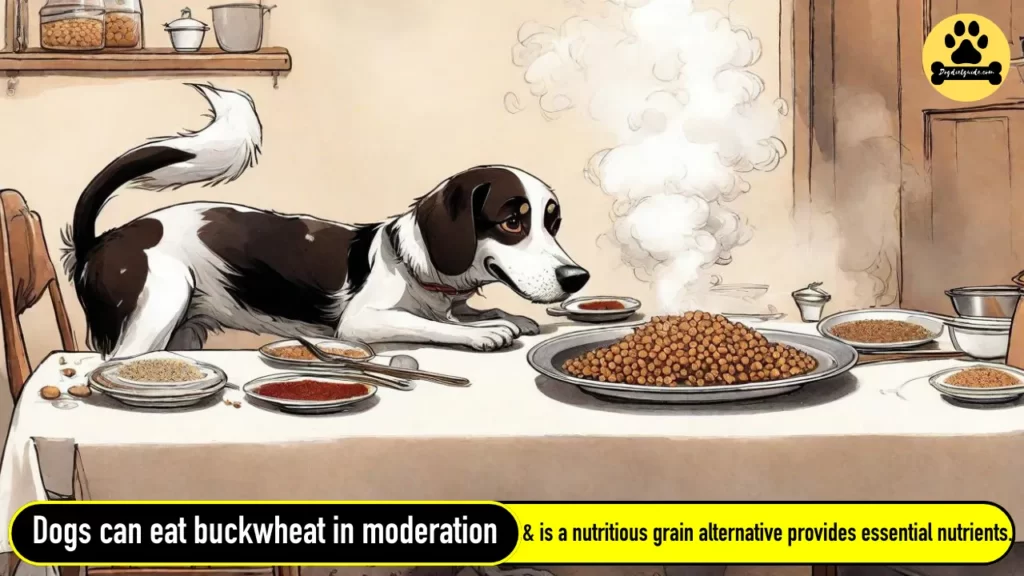Our four-legged friends’ well-being is paramount in the dynamic world of pet nutrition. As diligent pet parents, we often ponder new additions to our dogs’ diets. Buckwheat, a grain making waves in the health food scene, has now entered the canine culinary conversation. So, can dogs eat buckwheat?
Buckwheat emerges as a nutritional powerhouse for dogs.
Cooked buckwheat for dogs is rich in essential nutrients such as protein, fiber, and vitamins, contributing to your dog’s overall well-being. However, as with any addition to their diet, moderation is key. Ensure the seeds are thoroughly cooked and pureed into an easily digestible meal.
Dogs and Grains: A Delicate Balance
It is crucial to find the optimal balance between including grains in a dog’s diet and maintaining their overall well-being. While grains can provide essential nutrients, it’s necessary to approach their inclusion with care and moderation.
Understanding your dog’s dietary needs and consulting with a veterinarian can help ensure a healthy and balanced diet.
Can Dogs Eat Buckwheat?
Yes, dogs can eat buckwheat in moderation. Buckwheat is a nutritious grain alternative that provides essential nutrients such as protein, fiber, and vitamins. When feeding buckwheat to your dog, it’s necessary to cook it thoroughly and serve it in an easily digestible form, such as by pureeing it.
Always gradually introduce new foods to your dog’s diet to monitor for potential allergic reactions or digestive issues.
As with any dietary changes, it’s advisable to consult with your veterinarian to ensure that buckwheat is suitable for your dog’s specific health needs.

How Much Buckwheat For Dogs?
The safe amount of buckwheat for dogs can vary based on individual factors such as size, breed, age, and health status. It is suggested that you begin by offering approximately 1 cup (250ml) of cooked buckwheat for every 6 kilograms (about 13 pounds) of your dog’s body weight.
When introducing buckwheat, start with a small amount, such as a teaspoon, and carefully observe how your dog reacts. If there are no adverse effects, you can gradually increase the amount.
Monitoring your dog’s response is crucial to ensure they tolerate buckwheat well and not experience any digestive upset or allergic reactions.

Safe Buckwheat Amount For Dogs By Weight
| Dog’s Weight (kg) | Dog’s Weight (lbs) | Recommended Buckwheat Amount |
|---|---|---|
| Up to 3 kg | Up to 6.6 lbs | 1/2 cup (125 ml) |
| 4.5 kg | 10 lbs | 3/4 cup (185 ml) |
| 6 kg | 13.2 lbs | 1 cup (250 ml) |
| 9 kg | 19.8 lbs | 1.5 cups (375 ml) |
| 13.5 kg | 29.7 lbs | 2.25 cups (560 ml) |
| 18 kg | 39.6 lbs | 3 cups (750 ml) |
| 22.5 kg | 49.5 lbs | 3.75 cups (935 ml) |
| 27 kg | 59.4 lbs | 4.5 cups (1125 ml) |
| 31.5 kg | 69.3 lbs | 5.25 cups (1310 ml) |
| 36 kg | 79.2 lbs | 6 cups (1500 ml) |
Benefits of Buckwheat for Dogs
-
Buckwheat provides essential nutrients like fiber, protein, vitamins, and minerals for overall canine health.
-
Being gluten-free makes buckwheat suitable for dogs with gluten sensitivities or allergies.
-
The fiber in buckwheat aids digestion promotes a healthy gut and helps regulate bowel movements.
-
Buckwheat has a lower glycemic index, making it beneficial for canines, particularly those with diabetes, to manage blood sugar levels.
-
Buckwheat contains antioxidants, such as rutin, which may protect cells from oxidative stress and support the immune system.
-
The fiber content in buckwheat contributes to a feeling of fullness, potentially aiding in weight management by preventing overeating.
-
Buckwheat includes heart-healthy nutrients like magnesium and flavonoids, contributing to cardiovascular health in puppies.
-
Nutrients like manganese in buckwheat are essential for forming connective tissues and supporting joint health in dogs.

Is There Any Risk of Buckwheat for Dogs?
Feeding buckwheat to your furry friend can be a double-edged sword, presenting benefits and potential risks. While the cooked seeds of buckwheat offer a healthy and gluten-free alternative for your pet, it is crucial to be aware of the associated hazards.
The nutritional value of cooked buckwheat seeds makes them a viable option for your pet’s diet, serving as a wholesome alternative to treats or meals containing wheat. However, it is essential to exercise caution and avoid feeding other parts of the buckwheat plant to your pet.
One significant concern arises from fagopyrin, a compound found in the rest of the buckwheat plant. Fagopyrin has the potential to induce a painful reaction to sunlight, a condition known as photosensitivity. This adverse reaction can manifest in various ways, including photophobia (fear of sunlight), painful lesions on the skin, and, in severe cases, necrosis of the skin tissues.
When ingested in large quantities, the toxin fagopyrin can trigger hypersensitivity to sunlight in canines. This not only leads to discomfort and painful lesions but may also result in the development of necrotic skin tissues, posing a serious threat to your pet’s health.

Symptoms of Buckwheat Toxicity in Dogs
If a dog were to ingest a large amount of buckwheat or other parts of plants or if they have an underlying sensitivity, there is a possibility of adverse reactions. Symptoms of potential toxicity or adverse reactions to buckwheat in dogs may include:
- Gastrointestinal Distress:
- Vomiting
- Diarrhea
- Abdominal pain or discomfort
- Allergic Reactions:
- Itchy skin
- Hives
- Swelling, especially around the face, lips, or eyes
- Difficulty Breathing:
- Labored breathing
- Wheezing
- Coughing
- Lethargy:
- Unusual tiredness or lack of energy
- Increased Heart Rate:
- Rapid heartbeat
- Pale Gums:
- Buckwheat may affect blood circulation, leading to pale gums in severe cases.
Related Post: Can Dogs Eat Teriyaki Chicken?
Safe Ways to Include Buckwheat in Dog Food
Here are some safe ways to include buckwheat in your furry friend’s food:
Cooked Buckwheat thoroughly
Cook buckwheat thoroughly before serving it to your pup.
Boil or steam it without adding any salt, spices, or oils. Plain, cooked buckwheat can be mixed with your dog’s regular food.
Use Buckwheat Flour in Homemade Dog Treats
You can use buckwheat flour in homemade dog treats or food. Make sure to choose high-quality, whole-grain buckwheat flour without any additives.
You can find dog-friendly recipes online or create your own, keeping in mind your dog’s dietary needs.
Blend with Regular Dog Food
Mix cooked buckwheat with your pup’s regular food in moderate amounts.
Gradually introduce it to observe how your dog reacts. If there are any signs of digestive upset, discontinue use and consult your veterinarian.
Incorporate Buckwheat into Homemade Dog Treats
Incorporate buckwheat into homemade canine treats. Combine buckwheat flour with dog-friendly ingredients like peanut butter, pumpkin, or sweet potatoes to create tasty and nutritious treats.
Monitor Portion Sizes
While buckwheat can be a healthy addition, it should be given in moderation. Too much of any new ingredient can upset your dog’s stomach. Watch for any signs of allergies, sensitivities, or digestive issues.
Avoid Additives
Ensure that the buckwheat you provide your furry friend is plain and free from additives, such as salt or sugar.
canines do not need added seasonings, and some can harm them.
Always consult your veterinarian before making significant changes to your dog’s diet. They can provide guidance based on your dog’s individual health, age, and specific nutritional requirements.
How To Cook Buckwheat For Dogs?
Ingredients:
- Buckwheat groats
- Water
Instructions:
-
Start by measuring the amount of buckwheat groats you want to cook. The recommended serving size depends on your dog’s size and dietary needs. As a general guideline, you can start with 1/4 to 1/2 cup of buckwheat for small to medium-sized dogs and adjust accordingly.
-
Rinse the buckwheat groats under cold running water to remove dirt or debris.
-
In a saucepan, combine the rinsed buckwheat with water. The typical ratio is 1 part buckwheat to 2 parts water. For example, if you have 1 cup of buckwheat, add 2 cups of water.
-
Bring the water and buckwheat to a boil over medium-high heat.
-
Once it boils, reduce the heat to low, cover the saucepan with a lid, and let it simmer. Allow the buckwheat to cook for 15-20 minutes or until tender. Stir occasionally to prevent sticking.
-
Once the buckwheat is cooked, allow it to cool before serving it to your dog. Dogs may not enjoy hot food, and cooling it down also ensures it’s safe for them to eat.
-
You can enhance the flavor and nutritional value by mixing cooked buckwheat with other dog-friendly ingredients. Consider adding cooked vegetables, lean meats, or a small dog-friendly broth.
Related Post: Is Lemon Pepper Chicken Safe For Dogs?
FAQs
Can dogs eat buckwheat flour?
Yes, in moderation. Buckwheat flour is safe for dogs when cooked and used as an ingredient in dog-friendly recipes.
Can dogs eat buckwheat noodles?
Yes, in moderation. Plain, cooked buckwheat noodles can be given to dogs as an occasional treat, but avoid adding harmful seasonings.
Can dogs eat buckwheat pancakes?
It depends. Plain buckwheat pancakes can be safe for dogs in small amounts without added sweeteners or toppings like syrup. Avoid ingredients like chocolate and xylitol, which can be toxic to dogs.
Final Thoughts: Can Dogs Eat Buckwheat?
In canine nutrition, buckwheat is a promising option for discerning pet parents. While its nutritional benefits are undeniable, it’s crucial to approach dietary changes with caution and consult with your veterinarian. Balancing your dog’s diet is an art, and buckwheat can be a beautiful stroke in this culinary canvas.










![Can Dogs Eat Blood? 7 Side Effects [Expert Opinion]](https://petskor.com/wp-content/uploads/2022/04/Webp.net-resizeimage-12.jpg)
